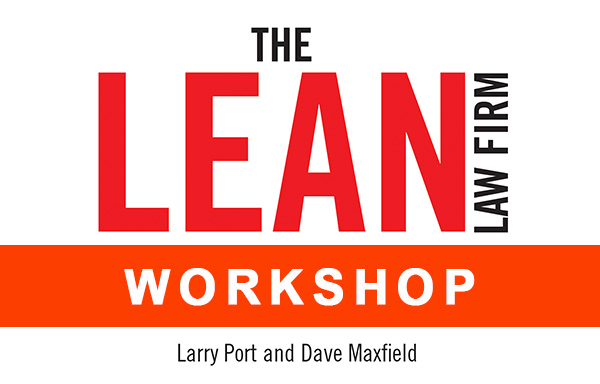How Do You Stack Up? Takeaways from our Lean Law Firm Workshop

Don’t you prefer it when CLEs are two-way discussions instead of one-way lectures?
That’s what my The Lean Law Firm co-author, Dave Maxfield, and I provided to a group of attorneys in a half-day collaborative workshop in Columbia, South Carolina.
We split up our curriculum into small, digestible chunks, interspersed with exercises and discussions to try to help attorneys go Lean. During the workshop, our lawyers began thinking of their firms as systems. They left with actionable steps they could implement immediately.
This workshop was the first time we presented The Lean Law Firm material in this way. Previously we conducted hour-long live sessions or webinars for bar associations. By collaborating with attorneys on Kanban boards, teaching them methods to predicts their revenue, identifying their most lucrative cases, and discussing their results, we came up with some pretty interesting observations:
1. Many law firms have an imprecise notion of how many cases they have going on at a given time. In Lean, we model cases as work-in-progress (WIP) inventory that travel through a firm much the way a car goes through an assembly line. If we know the number of cases we finish in a year (our throughput rate) and our average case unit value (ACUV), then we can determine our income.
Understanding how much inventory we have in our system will tell us if we will hit our revenue goals or not. Most participants have a general feel for their WIP, but no specifics.
2. Law firms struggle to identify their ACUV. Many lawyers in small firms, especially general practice ones, perceive their cases as so radically different from one another that they do not look for commonalities across them.
However, even if your cases are of a diverse nature, calculating ACUV is a must if we’re going to plan our revenue.
3. Lawyers have trouble separating cycle time from the hours worked on a case. One attorney discussed a favorable settlement. We asked what the cycle time was for the case, which is a measurement of how long a case is in a law firm from engagement to case closed and money collected.
The attorney answered “25 hours.” However, that’s not the correct answer. After probing deeper, the total cycle time for the case was actually 17 weeks!
Knowing the amount of hours worked on a case has definite benefits, but when we’re trying to predict revenue for the year, we need to focus on how many cases a firm can complete in a given time period, which is informed by cycle time.
4. Many law firms have no idea how to set revenue targets, and if they do, they have no idea how to achieve them. Setting a revenue goal is one of the most fundamental and basic aspects of running a business, yet professional service firms are often so focused on plying their trade that they neglect to do so.
If they clear this hurdle and set a revenue target, it’s often no more than a dart thrown at a wall based on last year’s numbers. There’s no method to it, and there are no behaviors or actions specified to arrive successfully at that number.
Chapter 10 of The Lean Law Firm describes exactly how to do this. The first step to getting there involves our Lean key performance indicators (KPIs): ACUV, throughput rate, and cycle time.
5. Many lawyers do not separate the “sales” part of their case lifecycle from the operational lifecycle of the case. When we discussed Kanban boards with law firms, we found that most lawyers included landing a client as part of the entire lifecycle of the case.
While it is true that closing a deal is a fundamental part of the overall client lifecycle, it needs to be separated out into its own process for two reasons. First, in order to determine cycle time, we cannot incorporate the sales process, because we’re trying to determine how long it takes us to work on and finish a case.
Second, by isolating the client intake process, a firm is better able to study it independently and optimize each component of it, resulting in better marketing and closing techniques.
Share post:







